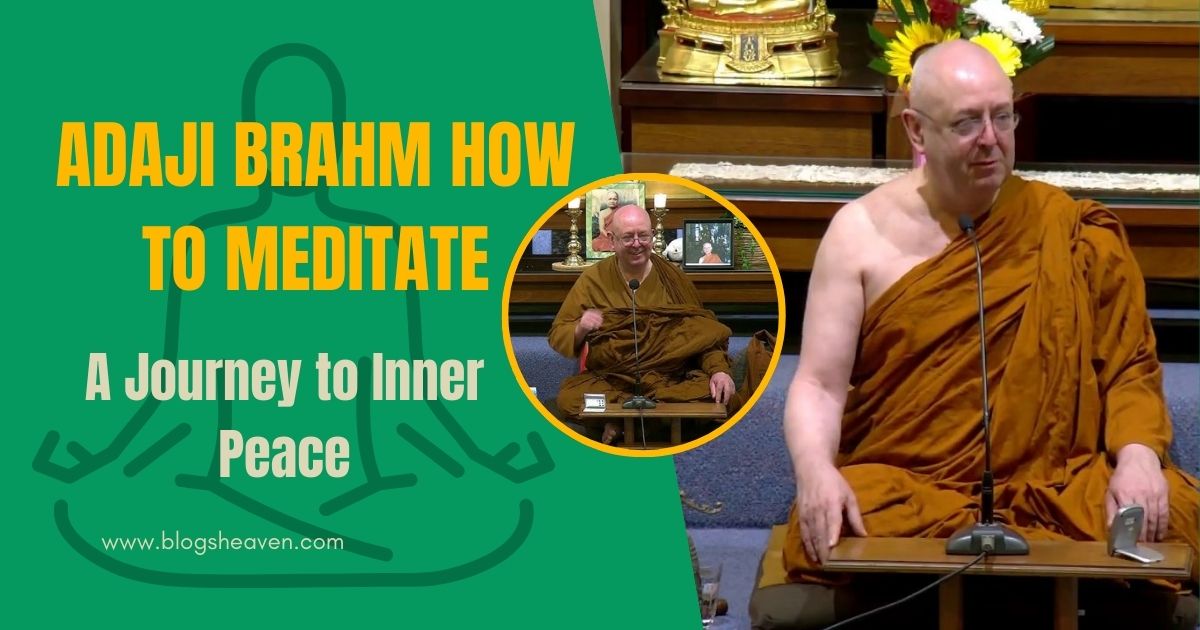The ancient art of meditation has recently become popular as a means to calm the mind and gain perspective in our hectic modern environment. Adaji Brahm How to Meditate? Provides a fresh perspective on the ancient practice. His methods are approachable to people of all skill levels because of his focus on presence, acceptance, and simplicity. This essay delves into the concepts and practices that Adaji Brahm suggests for a profoundly life-altering meditation routine.
The Essence of Meditation in Adaji Brahm’s Approach
Allowing the mind to relax naturally without pushing ideas away is central to Adaji Brahm’s meditation teachings. True serenity, according to his beliefs, comes from watching one’s thoughts without judgment. When practicing meditation, he suggests being soft and kind, allowing oneself to feel and think anything they want without attaching any value judgments. Looking at things from this angle makes room for the mind to relax and discover tranquility on its own.
Starting with Breath Awareness
According to Adaji Brahm, one of the first steps in meditation is to pay attention to your breathing. A basic practice that might help you focus and calm your mind is breath awareness. Relax into a straight-backed chair, shut your eyes, and pay attention to your breathing. Simply allow yourself to be with the air as it enters and leaves your body. This kind of mindful observation can help you focus and relax by bringing your attention to the here and now.
Observing Thoughts Without Judgment
Thoughts and distractions are natural parts of the meditative process. Rather than fighting them, Adaji Brahm says to just watch them. Consider your thoughts to be fleeting clouds in the sky. Recognize it, and then let it to float away. To get further into meditation, it is necessary to develop a sense of detachment, which this practice does. The ability to maintain composure and concentration in the face of distracting ideas will become second nature to you as time goes on.
The Power of Silence in Meditation
Adaji Brahm’s meditation technique heavily emphasizes silence. One way to tune into the “noise” of one’s own thoughts is to sit quietly. When you welcome this stillness, you open yourself up to seeing beyond your rushing mind and into a more profound state of consciousness. This stillness might be unsettling at first, but it brings great relief after some time spent practicing. When you’re alone with your thoughts and feelings, you may connect with yourself more deeply than when you’re with other people.
Practicing Self-Compassion During Meditation
Adaji Brahm’s meditation philosophy emphasizes self-compassion as a fundamental component. In times of mental wandering or restlessness, he says, meditators should be gentle with themselves. Being fully present is the goal of meditation, not perfection. If you adopt a caring frame of mind, you’ll be able to cultivate an environment free of criticism and stress, ideal for meditation.
Using a Timer to Stay Focused
If you find yourself looking at the time while meditating, Adaji Brahm recommends that you set a timer. Set a timer for five or thirty minutes, depending on how long you feel comfortable meditating for. When you’re ready, the session is over. If you use a timer, you won’t have to worry about how much time has passed throughout the exercise. If you want to meditate more deeply and without distractions, try this easy technique.
Cultivating Patience in Meditation
Patience is a virtue you’ll need on your path to meditation. Adaji Brahm cautions practitioners against expecting instant gratification. Meditation develops more profound with time, much like a seed. Even if you don’t sense a dramatic improvement after each session, try to see them as incremental steps ahead. With patience, you may let the practice develop on its own, bringing about a calm serenity that permeates your entire being.
Finding a Comfortable Meditation Posture
Adaji Brahm stresses the need of maintaining a relaxed posture. Find a comfortable spot to sit—on a cushion, in a chair, or even on your stomach if you have to—so you can avoid bending over or straining your back. The most important thing is to have a relaxed yet straight back. This position encourages awareness and helps you concentrate on the here and now as you meditate. If you want to be able to concentrate mentally when meditating, finding a comfortable position is essential.
Adaji Brahm How to Meditate: Letting Go of Expectations
Many people practice meditation with predetermined objectives, including alleviating stress or mending emotional wounds. Nevertheless, Adaji Brahm suggests that you release these anticipations. The best results from meditation come from letting go of expectations and just going with the flow. By keeping an open mind, you may remain calm and attentive throughout meditation, which will encourage it to develop in its own special way. Rather of fixating on the end product, one might find greater fulfillment in embracing the process.
Adaji Brahm How to Meditate: Guided Meditation as a Starting Point
Guided meditation is a great way for newcomers to Adaji Brahm’s teachings to ease into them. Direction and organization may be found in many of his courses that are available in audio or video forms. Starting off might be difficult without a system of self-direction, but guided sessions make it easy to unwind and concentrate. As you gain experience, you may find that quiet meditation suits you best, or you may find that a combination of the two works best for you.
Adaji Brahm How to Meditate: Adapting Meditation to Your Lifestyle
Sitting quietly is not the only way to meditate. Walking, eating, and even dishwashing are all examples of everyday tasks that Adaji Brahm suggests practicing mindfulness for. You may include meditation into your daily routine by giving your undivided attention to every activity. When these practices are integrated, it becomes simpler to live in a mindful manner, which in turn makes it easier to be calm and clear-headed even when not meditating formally.
Adaji Brahm How to Meditate: Handling Distractions Gracefully
With so much going on in the world, it’s hard to focus on anything for very long. Adaji Brahm says that one should accept such things calmly rather than getting agitated. Recognize the disturbance and bring your attention back to your breathing if it interrupts your meditation. This mild refocus strengthens your capacity to bounce back from setbacks and maintain composure under pressure. Distractions from the outside world will eventually have less of an effect on your ability to relax within.
Recognizing the Benefits of Meditation
Regular practice of Adaji Brahm’s meditation techniques has several advantages. Numerous people have reported feeling better emotionally, mentally, and physically. By strengthening your emotional resilience, meditation helps you face adversity with composure and clarity. Improved immunological function, reduced blood pressure, and greater sleep quality are just a few of the physical health advantages linked to meditation, according to research.
Adaji Brahm How to Meditate: Embracing Meditation as a Lifelong Journey
Rather than being a quick fix, meditation is a way of life. The key to successful meditation, according to Adaji Brahm’s teachings, is to focus on the process rather than the end result. Even if progress appears gradual, every session adds to your development. In time, meditation becomes a reliable friend, a means of weathering life’s storms with poise and wisdom.
Conclusion
Adaji Brahm How to Meditate? A deep sense of serenity and self-awareness is attained via guiding. Meditation is made approachable and gratifying by his method, which stresses patience, compassion, and attention. Developing a sense of inner peace and serenity through the practice of these methods can equip you to face adversity with poise and determination. When adhered to consistently, Adaji Brahm’s meditation techniques can lead one to true contentment and health.
FAQs
Can I meditate if I only have a few minutes each day?
Yes, even a few minutes daily can bring significant benefits. Start with what you can manage and gradually increase your time.
Should I sit cross-legged while meditating?
Not necessarily. Choose a position that is comfortable for you, as long as your spine is straight and relaxed.
Is it okay to fall asleep during meditation?
It happens, especially if you’re tired. Try meditating when you feel alert, or use a posture that promotes wakefulness.
What if I can’t stop my thoughts during meditation?
Don’t worry. Observing your thoughts without getting attached to them is part of the process. Gently bring your focus back to your breath.
Can I meditate to music or guided audio?
Yes, guided audio or calm music can be helpful, especially if you’re new to meditation. Over time, you may transition to silent meditation if desired.











